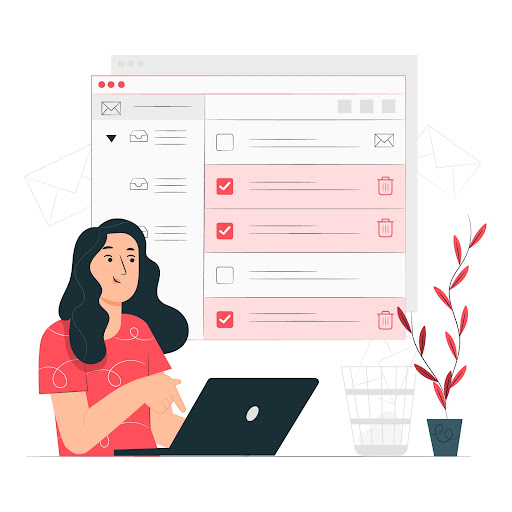
In the ever-evolving landscape of digital marketing, email campaigns stand as an undeniably powerful tool to engage audiences and drive conversion rates. However, a one-size-fits-all approach can often lead to underwhelming results. So, how can we ensure that our email campaigns hit the mark every time? The answer lies in a robust optimization strategy, and that's where A/B testing comes in.
A/B testing is a simple yet effective method that involves comparing two versions of a web page, email, or other marketing asset to see which one performs better. By evaluating two different versions with a subset of your audience, you can gauge the more successful variant, which can then be sent out to the rest of your audience.
In this article, we'll delve into the benefits of A/B testing in your email campaigns and present a step-by-step guide to implementing it effectively.
It’s crucial to grasp the basics of A/B testing. A/B testing, also known as split testing, involves creating two versions of an email, the original (A) and the variant (B). These versions are identical except for one difference – the variable you're testing. You then split your email list into two random, equal groups, send Group A the original email and Group B the variant email, and monitor their performances based on a predetermined goal.

A/B testing offers numerous benefits that can significantly enhance the effectiveness of your email marketing strategy, including increased open rates, enhanced click-through rates, and overall improvement in email performance. Let's take a closer look.
One of the first significant benefits of A/B testing your emails is the potential for improved open rates. The open rate is the percentage of email recipients who open a given email. A/B testing can help you optimize various elements that impact open rates, such as the subject line, pre-header text, sender name, and the time and day of sending. By testing these elements, you can understand what prompts your audience to open your emails, leading to a higher open rate.
The click-through rate (CTR) is another key metric in email marketing, representing the proportion of email viewers who clicked on one or more links contained in an email. CTR is directly related to the content of your email, such as the body copy, images, links, and call-to-action buttons. By A/B testing these elements, you can optimize your content to drive more clicks and, consequently, increase your CTR.
Conversion rate is a critical metric that measures the percentage of email recipients who complete a desired action, such as making a purchase, signing up for a service, or filling out a form. A/B testing can be instrumental in improving conversions by testing different aspects of your email that influence a recipient's decision to take action. This includes the offer, the wording of your call to action, the layout, and design of your email, and more.
Bounce rate refers to the percentage of emails sent that could not be delivered to the recipient's inbox. Hard bounces occur when delivery is attempted to an invalid, closed, or non-existent email address, and soft bounces are temporary delivery failures due to a full inbox or an unavailable server. A/B testing can help identify factors contributing to bounce rates, allowing you to rectify them and ensure your emails are successfully reaching your subscribers' inboxes.
Another way to avoid a high bounce rate is to clean your email list regularly. Delete invalid email addresses before each campaign to make your email campaign even more effective. But it takes a lot of time to do this manually, and you won't always be able to objectively evaluate a particular email address. Use Atomic Email Verifier, This tool will clean your email list from invalid emails in just a couple of clicks.

Another significant benefit of A/B testing is that it helps you understand your audience better. Different audiences respond differently to various types of emails, and A/B testing can help you discover what resonates most with your specific audience. By gaining insights into your audience's preferences and behaviors, you can create more targeted and personalized email content, leading to improved performance.
A/B testing provides data-driven insights that help make informed decisions about your email marketing strategy. Rather than relying on intuition or assumptions, you can use the results from your A/B tests to guide your decisions and enhance your email marketing effectiveness. This evidence-based approach helps minimize risks and can lead to better results.
A/B testing is a cost-effective method to improve your email marketing. It allows you to get the most out of your existing audience by optimizing your emails based on their preferences and behaviors. Instead of spending more money on acquiring new leads, you can boost your results by improving your engagement with your current subscribers.
The practice of A/B testing encourages continuous improvement. As you continue to test, learn, and optimize, you are constantly improving the effectiveness of your emails. Each test offers valuable insights that you can apply to future emails, helping you create an increasingly effective email marketing strategy over time.
Conducting an A/B test may seem daunting, but by following this step-by-step guide, you can easily implement A/B testing in your email marketing strategy.
Before initiating A/B testing, it's essential to define your goals. Without a clear goal, you'll be shooting in the dark and won't know what success looks like. What do you aim to improve through testing? Is it the open rate, click-through rate, conversion rate, or something else? Your goals should be specific, measurable, achievable, relevant, and time-bound, or SMART (Specific, Measurable, Achievable, Relevant, and Time-bound). For example, you may aim to increase your email open rate by 10% within the next month. Having a clear goal will guide your testing process, helping you decide what elements to test and what metrics to monitor.
Next, you need to identify which elements of your email campaign to test. Remember, it's important to test one element at a time to avoid any confusion about what caused any changes in performance.
Here are two common elements that can significantly impact the performance of your emails:
Subject lines are often the first point of contact in your email campaign. It plays a significant role in influencing whether a recipient opens your email or sends it straight to the trash. Subject line testing can help you understand what draws your audience in and compels them to open the email.
You might test various aspects of your subject lines, such as:
The CTA is arguably the most critical part of your email. Your CTA is what drives your recipients to act, whether that's visiting your website, making a purchase, or registering for an event. Testing different CTAs, from their language to their design and placement, can significantly impact your click-through and conversion rates. Here are some elements you can test:

Personalization can make your emails feel more relevant and tailored to the individual recipient. This can lead to higher engagement rates. Here are a few ways you can test personalization:
The body of your email is where you convey your message and engage your audience. There are many elements within the body that you can test, including:
Once you've defined your goals and identified your testable elements, it's time to split your audience. In an A/B test, your audience should be split into two equal and randomly selected groups: Group A (the control group) and Group B (the test group). Group A will receive the original version of your email, while Group B will receive the altered version. This division is typically 50/50, but it can vary based on your campaign size and goals. Ensure that the audience segmentation is random to prevent bias and keep the test conditions consistent. The size of each group will depend on the size of your email list and the statistical significance you wish to achieve. Ensure that the groups are representative of your overall audience to obtain accurate results.
Determining the appropriate sample size and test duration is a critical step in your A/B testing journey. The sample size should be large enough to yield statistically significant results, while the duration should be long enough to capture meaningful data but not so long that the test becomes obsolete. A short test may not give you enough data for reliable results, while a prolonged test can lead to changes in external factors that could affect the outcomes. Typically, a testing period of 7 to 14 days is recommended.
Tools like an A/B Test Sample Size Calculator can help you determine the optimal group size.
After dividing your audience and determining the sample size and duration, you can begin your test. Most email marketing platforms have built-in A/B testing tools, making it relatively easy to execute your test. As your test runs, it's important to monitor the results closely. Look out for significant changes in the metrics you've set out to improve.

Once your test has concluded, it's time to analyze and compare your results. Look at the key metrics associated with your goals – open rates, click-through rates, conversion rates, etc. – and determine which version of your email performed better.
Use statistical significance tests to ensure that your results are not due to random chance. If you're not comfortable with statistics, various online tools and calculators can help you with this.
Based on your analysis, select the winning version of your email. This should be the version that best met your testing goals. This is the version that you'll send out to the rest of your audience. Remember, even if the results aren't what you expected, there's value in learning what doesn't work with your audience. Remember, the goal of A/B testing is to continually improve, so don't stop testing after a single run.
The final and perhaps most important step in the A/B testing process is repetition. A/B testing isn't a one-and-done strategy; it's a continuous cycle of testing, analyzing, implementing, learning, and then testing again.
The objective behind repeating the testing process is to foster a culture of continuous improvement. With each iteration of a test, you gain more insights into your audience’s preferences and behaviors. As you implement the winning versions, your email marketing gradually becomes more effective, leading to improved engagement and conversion rates. However, this doesn't mean that there's an endpoint or a «perfect» email that you will eventually arrive at. Customer preferences, industry trends, and digital landscapes change, which means what worked today may not work tomorrow. Therefore, consistent testing and optimization are crucial to staying relevant and effective.
After you've tested a variable and implemented the winning version, move on to the next element you want to optimize. For example, if you started by testing the subject line, you might move on to the email body, CTA, or personalization elements next. Alternatively, you can further test the same variable but with a different hypothesis. If you initially tested the length of the subject line, you can next test the tone or use of personalization in the subject line.
It's also a good idea to re-test the same variables after a certain period. As mentioned earlier, preferences can change, and what worked six months ago might not be as effective today. Periodic re-testing ensures that your strategies are up-to-date with your audience's current preferences.
As you get more comfortable with A/B testing, consider expanding your tests. While it's recommended to change only one variable at a time when starting, multivariate testing — testing multiple changes simultaneously to see how combinations of variations perform — can provide more nuanced insights as your marketing strategy evolves.
Finally, each A/B test, regardless of the result, is an opportunity to learn more about your audience. Even if a test doesn't yield a significant difference, it's still valuable information that helps shape your understanding. By documenting and learning from each test, you build a rich reservoir of knowledge about your audience that can guide not just your email marketing strategies but also other areas of your marketing.
Statistical significance is a crucial concept in hypothesis testing, including A/B testing in email marketing. It's a way of quantifying the likelihood that the results of your test happened by chance.
In the context of A/B testing, achieving statistical significance means there's a high degree of certainty that the differences in performance between version A and version B are due to the changes you made, not random variations.
Statistical significance in testing is usually expressed as a p-value, which represents the probability that the observed difference occurred by chance if there's no actual difference between the two groups (null hypothesis). A commonly used threshold for statistical significance is 0.05 (or 5%).
If the p-value is less than or equal to 0.05, the difference is considered statistically significant. It means that if there were no real difference between A and B, you would get a result as extreme as the one you have (or more so) only 5% of the time.
Conversely, a p-value greater than 0.05 indicates that the observed difference might have occurred by chance and is not statistically significant. In this case, you would not reject the null hypothesis.
However, statistical significance doesn't automatically imply that the results are practically or clinically significant. For instance, a small difference in click-through rate might be statistically significant if your sample size is large enough, but it might not be significant enough to impact your business outcomes or warrant changing your email strategy.
Therefore, while statistical significance is an essential tool for interpreting your A/B test results, it should be used in conjunction with practical significance and your business goals to make informed decisions.
Additionally, remember that achieving statistical significance in an A/B test is not the end goal. Rather, the goal is to learn about your audience's preferences and behaviors and use those insights to improve your email marketing effectiveness. Achieving statistical significance simply gives you greater confidence in the validity of these insights.

To get the most out of your A/B email testing, it's crucial to adopt some best practices. These guidelines will help you design and execute effective tests, as well as interpret the results accurately.
A/B testing is an indispensable tool for optimizing your email campaigns. By systematically testing different elements of your emails, you can gain deep insights into your audience's preferences, leading to increased open rates, click-through rates, and overall campaign performance.
The process may seem intricate at first, but with careful planning and execution, you can maximize the potential of your email marketing efforts. Remember, the key to successful A/B testing is constant iteration; each test provides invaluable insights that can further refine your approach.
For regular, high-quality A/B testing, choose a reliable mass email sender that not only allows you to flexibly customize your emails but also gives you access to all the necessary metrics. Atomic Mail Sender has a wide range of features that allow you to conduct and monitor testing of any email variations. Plus, you can explore all its features for free during a seven-day trial period.
So, start A/B testing your email campaigns today, and unlock the potential to make your marketing efforts more targeted, more engaging, and ultimately, more successful.
Increase your productivity and conversions by downloading it today!
Download now


Subscribe to us and you will know about our latest updates and events as just they will be presented





